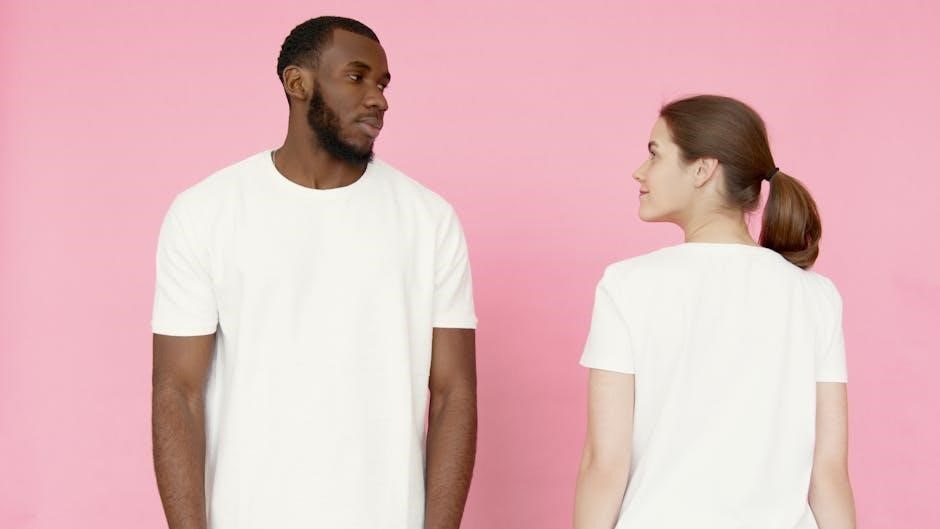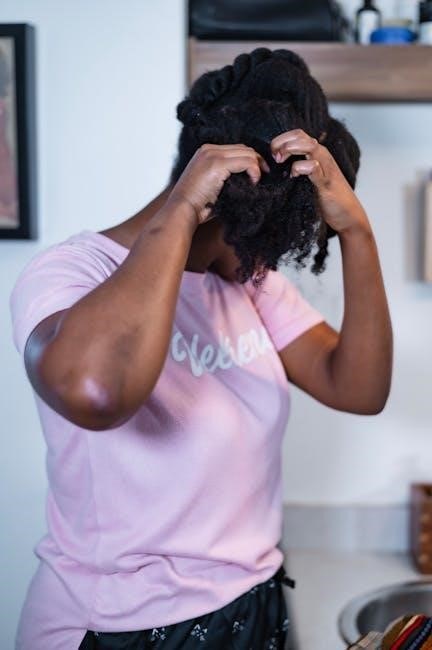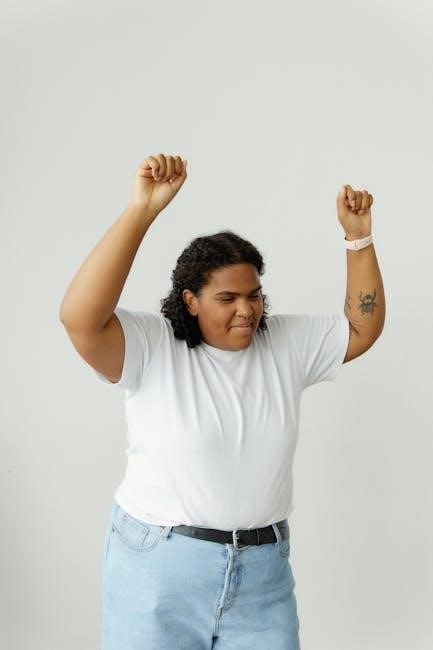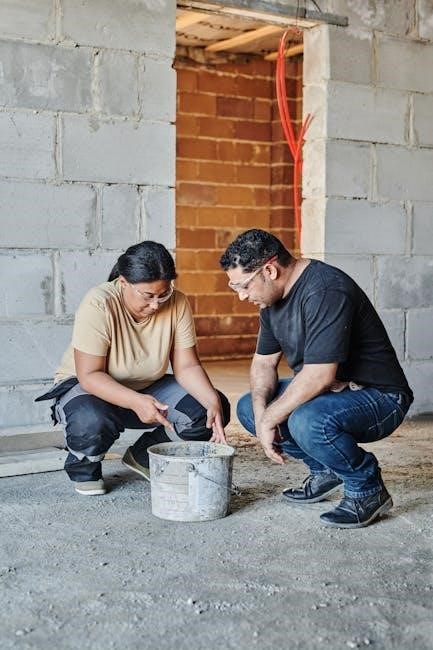womens t shirt size guide
Welcome to the ultimate guide for finding your perfect women’s t-shirt size! Discover how to navigate size charts, ensure a flawless fit, and boost your style and confidence.
Overview of T-Shirt Sizing
T-shirt sizing for women is designed to provide a comfortable and flattering fit based on standard body measurements. Sizes typically range from Small to 3X-Large, with each size corresponding to specific chest, waist, and hip measurements. However, sizing can vary slightly between brands due to differences in cut, fabric, and design. Understanding how sizes are categorized helps women choose the right fit for their body type and personal style. Proper sizing ensures comfort, mobility, and an appealing appearance, making it essential to familiarize oneself with size charts and measurements. This guide will help navigate the nuances of women’s t-shirt sizing to make informed purchasing decisions.
Importance of Proper Fit
A proper fit in women’s t-shirts is crucial for both comfort and confidence. A well-fitting shirt allows for a full range of motion and avoids restrictive tightness or unflattering looseness. It enhances the wearer’s silhouette, creating a polished and put-together appearance. Ill-fitting t-shirts can lead to discomfort, visible strain, or an unflattering shape, which can dampen confidence. Additionally, proper fit ensures the garment lasts longer, as it isn’t stretched or strained excessively. Investing time in finding the right size pays off in terms of style, comfort, and durability. A good fit elevates the overall aesthetic and ensures the wearer feels their best, making it a cornerstone of a well-curated wardrobe.

Understanding Women’s T-Shirt Size Charts
Women’s t-shirt size charts are guides listing measurements for each size, helping determine the best fit based on body measurements and desired comfort level.
Standard Size Charts
Standard size charts provide a universal guide for women’s t-shirt sizing, categorizing sizes from Small to Extra-Large based on common body measurements. These charts typically include measurements for the bust, waist, and sometimes hip circumference to help determine the best fit. While sizes may vary slightly between brands, standard charts offer a consistent reference point for consumers. They often list numerical measurements in inches or centimeters, making it easier to compare and choose the right size. However, it’s important to note that standard charts may not account for variations in fabric stretch or unique body types, which can affect the fit. Always measure yourself accurately for the most reliable results.
How Size Charts Vary by Brand
Size charts for women’s t-shirts can differ significantly between brands due to varying fits, target audiences, and design philosophies. Some brands cater to petite or plus-size women, offering specialized sizing. Others focus on specific fits like slim, relaxed, or oversized. Fabric type and stretch also influence sizing, as some materials naturally have more elasticity. Brands may prioritize different measurements, such as bust, waist, or hip, leading to discrepancies. Additionally, some labels adopt vanity sizing, where sizes are adjusted to flatter customers. This variability means a size 8 at one brand might fit like a 10 at another. Always consult the specific brand’s size chart for accurate sizing.
International Size Conversions
International size conversions are essential for ensuring a proper fit when shopping across global brands. Women’s t-shirt sizes vary significantly between regions due to different measurement standards and body type assumptions. For instance, a US size 8 might correspond to a UK size 10 or a European size 36. These discrepancies often stem from varying fits, as some countries prefer looser or tighter garments. To navigate this, use a reliable size conversion chart tailored to your region and the brand’s origin. Additionally, consider fabric elasticity, as stretchiness can affect fit. While conversion charts provide guidance, remember that brands may have unique fits, so checking specific brand size guides or customer reviews can help achieve the best fit.

Body Measurements for Accurate Sizing
Accurate body measurements ensure the best fit for women’s t-shirts. Measure bust, waist, and hips with a flexible tape measure. Keep it level and not too tight.
How to Measure Yourself
To ensure accurate sizing, measure yourself wearing a non-padded bra and stand up straight. Use a flexible tape measure and keep it level. Start with your bust: wrap the tape around the fullest part, keeping it parallel to the floor. For your waist, measure the narrowest point, usually just above your belly button. Hip measurements are taken around the widest part of your hips and buttocks, about 7-9 inches below your waistline. Take note of these measurements and compare them to the size chart. For the best fit, avoid pulling the tape too tight or leaving it too loose. Measure twice to confirm accuracy.
Key Measurements for T-Shirt Sizing
The key measurements for determining women’s t-shirt sizes are bust, waist, and hips. The bust measurement is the most critical, as it directly affects how the t-shirt fits across the chest. Measure around the fullest part of your bust, keeping the tape measure level and parallel to the floor. The waist measurement, taken at the narrowest point of your natural waistline, helps determine the fit around the midsection. Hip measurements, taken 7-9 inches below the waist, ensure the shirt is proportionate to your body. These measurements are then compared to size charts to find the best fit. Accurate measurements ensure comfort and a flattering silhouette.

Types of T-Shirt Fits
Women’s t-shirts come in various fits, including Regular, Slim, Oversized, and Boxy. Each fit offers a different silhouette, catering to personal style and body types.
Regular Fit
A Regular Fit t-shirt provides a classic, timeless silhouette that skims the body without being too tight or too loose. Designed for everyday wear, it offers comfort and versatility, making it suitable for most body types. The Regular Fit typically has a straight cut with moderate ease through the chest and waist, ensuring ease of movement. It’s ideal for women who prefer a relaxed yet flattering look that isn’t overly form-fitting. This fit works well for layering or standalone styling and is a popular choice for casual outings. The measurements are balanced, ensuring the shirt drapes naturally without restriction, making it a go-to option for effortless style.
Slim Fit

A Slim Fit t-shirt is designed to hug the body closely, creating a modern and streamlined appearance. It is tailored to skim the curves without being overly tight, offering a fashionable yet comfortable choice. This fit is ideal for women who prefer a more contoured silhouette and is often paired with high-quality fabrics that provide stretch for ease of movement. The Slim Fit is perfect for layering or worn on its own, making it versatile for various occasions. It is particularly flattering on petite frames or those with hourglass figures, as it accentuates the waistline while maintaining a sleek look. The Slim Fit strikes a balance between style and comfort, making it a popular choice for everyday wear.
Oversized Fit
An Oversized Fit t-shirt offers a loose, relaxed silhouette, providing maximum comfort and a casual, trendy appearance. This style is designed to be worn with plenty of room, often featuring a boxy shape and dropped shoulders. The Oversized Fit is perfect for layering or as a standalone statement piece. It flatters a variety of body types, including pear-shaped and athletic builds, by creating a balanced proportion. The loose fabric drapes effortlessly, making it ideal for relaxed outings or lounging. Pair it with fitted bottoms for a chic contrast or with loose pants for a laid-back vibe. The Oversized Fit is a versatile choice for those who prioritize comfort while maintaining a fashionable look.
Boxy Fit
A Boxy Fit t-shirt is characterized by its square-like silhouette, offering a relaxed and casual look. Unlike slim or regular fits, it has a loose, straight cut from the shoulders to the hem, creating a boxy shape. This style is ideal for women who prefer a comfortable, non-restrictive fit or want to achieve a trendy, oversized aesthetic. The Boxy Fit is particularly flattering for petite women, as it adds visual proportions, and for those with hourglass figures, as it balances curves. Pair it with high-waisted pants or skirts for a stylish contrast. Opt for lightweight fabrics like cotton or linen to enhance the effortless drape of this fit. It’s perfect for casual outings or layering, offering both comfort and a modern appeal.

Factors Influencing Fit
Fabric type, neckline style, and body proportions significantly impact how a t-shirt fits, ensuring comfort and flattery across different body types and personal preferences.
Fabric and Material
The choice of fabric and material significantly impacts the fit and comfort of a women’s t-shirt. Cotton is the most common fabric, known for its breathability and softness, while polyester blends offer durability and moisture-wicking properties. Rayon or bamboo fabrics provide a lightweight, silky texture, often preferred for their drape and comfort. The thickness and stretch of the fabric also play a role; for example, thicker fabrics like pure cotton may fit snugly, while fabrics with elastane offer more flexibility. The weave and weight of the material can affect how the t-shirt drapes on the body, influencing the overall fit. Considering the fabric type helps ensure both comfort and a flattering silhouette.
Neckline Styles
Neckline styles significantly influence the fit and aesthetic of a women’s t-shirt. Crew necks are the most common, offering a classic, versatile look that suits most body types. V-necks elongate the neck and can draw attention upward, flattering those with shorter torsos. Scoop necks provide a wider, more relaxed opening, while boat necks sit wider on the shoulders, creating a balanced silhouette. Each neckline style impacts how the t-shirt fits around the shoulders and chest, affecting comfort and appearance. Understanding personal preferences and body proportions helps in selecting the most flattering neckline. These variations ensure a customized fit, making the t-shirt suitable for diverse styles and occasions.
Occasion and Style
The occasion and personal style play a significant role in choosing the right women’s t-shirt size. For casual outings, a relaxed or oversized fit paired with jeans or shorts is ideal. Formal events may call for a slim-fit t-shirt in a premium fabric, layered under a blazer for a polished look. Athletic activities require moisture-wicking fabrics and a fitted silhouette for comfort and performance. Additionally, personal style influences fit preferences—some may prefer a trendy cropped fit for high-waisted pants, while others opt for a loose, bohemian-inspired look. Considering the occasion and personal aesthetic ensures the t-shirt complements the overall ensemble, making it versatile for various settings and fashion choices.

Choosing the Right Size
Use size charts, consider fit preferences, and measure accurately. Opt for a size that balances comfort and style, ensuring proper drape without being too tight or loose.
When to Size Up or Down
Deciding whether to size up or down depends on fit preference, fabric, and body type. If you prefer a looser fit, size up; for a snug look, size down. Consider the fabric’s stretch—stretchy materials allow sizing down, while non-stretch fabrics may require sizing up. Petite women may need smaller sizes for proportion, while taller women might size up for comfort. Layering purposes also influence sizing choices. For example, a larger size is better for layering, while a smaller size suits standalone wear. Personal comfort and style trends, like oversized or fitted silhouettes, should guide your decision. Always refer to brand-specific charts for accurate sizing adjustments. Balance comfort and aesthetics for the perfect fit.
Role of Stretch and Elasticity
Stretch and elasticity play a crucial role in determining the comfort and fit of a women’s t-shirt. Fabrics with high elasticity, such as cotton-poly blends or tri-blends, provide a snug fit while allowing freedom of movement. T-shirts with stretchy materials, like spandex or bamboo, adapt to body shapes, ensuring a flattering silhouette. The level of stretch can influence size choices—high-stretch fabrics may allow sizing down, while low-stretch fabrics may require sizing up; Elasticity also affects durability, as stretchy fabrics retain their shape longer. Consider the activity and desired comfort level when selecting fabric type. A balance of stretch and structure ensures both style and comfort, making elasticity a key factor in achieving the perfect fit for any body type or lifestyle.
Using Brand-Specific Size Charts
Brand-specific size charts are essential for ensuring the best fit, as sizing can vary significantly between brands. Each brand tailors its sizing to its target audience, design aesthetic, and fabric types. To use these charts effectively, compare your measurements to the brand’s specific guidelines rather than relying on generic sizes. Pay attention to details like chest, waist, and length measurements, as these often differ. Some brands also provide fit notes, such as whether a style runs small, true to size, or large. Double-checking these charts before ordering can help reduce the likelihood of sizing errors and ensure a more accurate fit tailored to the brand’s unique specifications and design intent.

Common Mistakes in Sizing
Common mistakes in sizing include ignoring body measurements, not checking fabric stretch, assuming standard sizes across brands, and not considering fit types like slim or oversized.
Ignoring Body Measurements
One of the most common mistakes when choosing a women’s t-shirt size is ignoring body measurements. Many women rely solely on standard size labels, assuming they correlate with fit. However, body proportions, such as bust, waist, and shoulder measurements, significantly impact how a t-shirt drapes. Neglecting to measure oneself can lead to ill-fitting garments that are either too tight or too loose. To avoid this, it’s essential to take accurate measurements, focusing on the bust and waist, as these are critical for t-shirt sizing. Using these measurements to compare with size charts ensures a better fit. Ignoring body measurements often results in discomfort and an unflattering appearance, making it a mistake to avoid for the best shopping experience.

Style Tips for Different Body Types
Flatter your figure with tailored fits: V-necks for petite frames, A-line shirts for pear shapes, and relaxed fits for athletic builds.
Petite Women
Petite women should opt for T-shirts that create a balanced, proportional silhouette. Look for styles with shorter hems to avoid overwhelming the frame. V-necks or scoop necks elongate the torso, while crew necks can add width to the shoulders. Cap sleeves or short sleeves are ideal, as they draw attention to the upper body without adding bulk. Avoid oversized fits, as they can make petites appear even smaller. Instead, choose tailored or semi-fitted designs that skim the body. Pairing T-shirts with high-waisted pants or skirts creates a lengthening effect. Additionally, vertical stripes or subtle patterns can create a slimming, elongated look. Prioritize high-quality, stretchy fabrics for comfort and a polished appearance.
Tall Women
Tall women should seek T-shirts that balance proportions and create a flattering silhouette. Opt for longer hemlines to avoid a boxy appearance and ensure coverage. A-line or relaxed fits can skim the body without clinging, while V-necks or scoop necks draw the eye upward, elongating the torso. Cap sleeves or three-quarter sleeves are ideal, as they add structure without overwhelming the frame. High-quality, drapey fabrics are recommended for a smooth fit. Pairing T-shirts with high-waisted pants or skirts creates a balanced look. Layering with cardigans or jackets can add dimension and draw focus to the upper body. Vertical stripes or asymmetrical details can also enhance length. Prioritize structured fabrics to maintain shape and avoid clinginess.
Hourglass Figures
Women with hourglass figures should highlight their curves with tailored T-shirts. Look for styles that cinch at the waist or have princess seams to accentuate the bust and define the waistline. V-neck or scoop necklines draw attention to the décolletage and balance the hips. Fitted silhouettes that skim the body are ideal, avoiding boxy or oversized fits that hide curves. Ruching or gathering details can add texture and emphasize the waist. Pairing with high-waisted jeans or pencil skirts creates a balanced, feminine look. Avoid oversized sleeves that overwhelm the frame. Opt for stretchy fabrics that hug curves without restricting movement. Emphasize the natural silhouette with structured designs that create a polished, put-together appearance while maintaining comfort and confidence.
Pear-Shaped Bodies
For pear-shaped bodies, balance is key. Opt for T-shirts with an A-line silhouette or flared hem to skim over the hips and thighs, creating a more proportionate look. V-neck or scoop necklines draw attention upward, elongating the torso and balancing broader lower halves. Avoid clingy fabrics that emphasize the hips; instead, choose structured or stretchy materials that skim the body. Pair with tailored trousers or skirts that hit just above the knee to elongate the legs. Details like ruffles or embroidery on the top half can distract from the hips, while side pockets or asymmetrical hems add visual interest. Aim for a fit that’s neither too tight nor too loose to maintain comfort and confidence. This approach ensures a flattering, balanced appearance for pear-shaped figures.
Athletic Builds
For women with athletic builds, choosing the right T-shirt involves balancing comfort and flattery. Opt for slim-fit or semi-fitted styles that accentuate toned muscles without being too restrictive. Moisture-wicking fabrics are ideal for active lifestyles, keeping skin dry and comfortable. V-neck or scoop necklines can elongate the torso and draw attention upward, balancing broader shoulders. Consider longer-length tees for coverage and pairing with high-waisted bottoms. Cap sleeves or sleeveless options highlight defined arms, ensuring a flattering fit. Proper measurements are key to avoid tightness around the bust or looseness at the waist. Look for brands offering athletic-specific lines that provide four-way stretch for enhanced mobility. Accessorizing with jackets or statement jewelry can add style while maintaining functionality. Prioritize comfort and support without compromising on fashion.

Comparing Sizes Across Brands
Women’s T-shirt sizes vary significantly across brands due to differences in measurement standards, fit preferences, and fabric. Always consult brand-specific size charts for accuracy, as sizing can differ by inches or centimeters. Some brands offer petite or tall ranges, while others focus on relaxed or fitted silhouettes. Fabric type and elasticity also influence fit, making direct comparisons challenging. Use brand-specific guides and customer reviews to ensure the best match for your body type and preferred style. Understanding these variations helps in making informed purchasing decisions and achieving a flattering, comfortable fit.
Understanding Brand-Specific Fits
Each brand tailors its T-shirt fits to cater to specific body types, lifestyles, or fashion trends. Some brands prioritize a relaxed, oversized silhouette, while others focus on slim, form-fitting designs. Measurements for bust, waist, and length vary between brands, even within the same nominal size. For example, one brand’s medium might align with another’s small due to differences in fabric stretch or cut. Additionally, certain brands specialize in petite or plus-size ranges, offering fits that flatter those body types uniquely. Always consult a brand’s size chart and customer reviews to gauge how their T-shirts fit before making a purchase. This ensures a more accurate and comfortable choice tailored to your preferences.
Finding the perfect T-shirt fit requires understanding your measurements, exploring brand-specific sizing, and considering your personal style. Experiment with fits and fabrics to enhance comfort and confidence in your wardrobe choices.
Final Thoughts on Finding the Perfect Fit
Finding the perfect fit for a women’s T-shirt involves a combination of accurate measurements, understanding size variations, and personal style preferences. Always consider the fabric, neckline, and intended use to ensure comfort and flattery. Experiment with different fits like slim, oversized, or boxy to discover what complements your body type. Don’t hesitate to size up or down based on stretch and elasticity, as this can significantly impact comfort. Referencing brand-specific size charts is crucial, as sizing can vary greatly. Lastly, embrace your unique silhouette and prioritize confidence—ultimately, the right fit is one that makes you feel great. Happy shopping!
